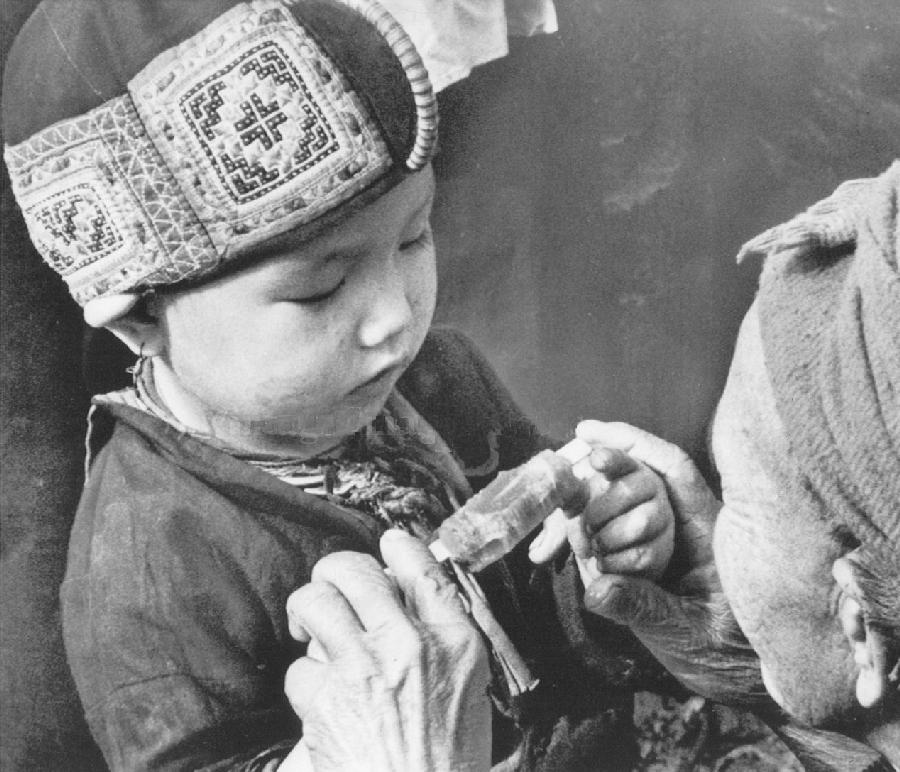
Vietnam: Ethnicity

Figure 1.-- This little Meo refugee girl is being introduced to a popcycle. The Meo were one of the tribes the French regerred to as Montagnards, meaning mountain or hill people. Her family was driven by the Nirth Vietnamese from their home in the Vietnamese Central Highlands to a refugee camp in the Laos plains. The press captuion read, "A young Meo girl dressed in traditional ciostume ate ice cream from a stick with the help of her grandmother at a refugee camp in Laos. The Meos have been driven from their land by the war and must now live in the plains instead of their mountain areas, whre they grew opium as the main cash crop."
|
|
Vietnam has a poulation of some 85 million people. Accounts vary, but nearly 90 percent of these appear to be ethnic Vietnamese or Kinh people. (The Vietnamese used the term Vietnamese as a natiuoinal term and the Kinh for the specifically Vietnamese ethnic group. The earliest known name for the ancient Vietnamese people is Lạc. The word Việt is a shortened from of Bách Việt, a name used in ancient times. Nam refers to 'south' meaning what thecChinese would see as south. The ethnolinguiustic pattern of the Vietnamese is extrodunarily complex, affected by the different peoples who inhabit Southeast Asia and the rise and fall of powerful empires over several millennia. The Vietnamese/Kinh people inhabit the Red River delta, the central coastal delta, the Mekong delta and major cities. The Vietnamese majority was substanially Sinicized during a millennium of Chinese rule during the first millennium of the modern era (ending 939 AD). This of course was most pronounced in the north. Although geographically and linguistically Vietnam is categorized as part of Southeast Asians, the Chinese domination and influence meant that culturally the Vietnmese are more a part of East Asia. Ethnically they are largely Southeast Asian with an important Chinese admixture. Modern DNA evidence help to show relationships long lost to history. Obe study reports southeast Asian/Oceanic origins (83 percent), East Asian (12 percent), and Southern Asia (3 percent). [National Geographic Society] East Asian rfers here to China and South Asia to India. The Nationl Geographic Researchers reoport, "The large Eastern Asia and Southeast Asia percentages are representative of two separate migrations to the region, with the Southeast Asian component likely representing a composite of some of the earliest settlers of the region." There is considerable ethnic diversity between north and south with minorities of considerable importance in the central highlands. There has also been an Indian influence, albeit smaller. It is most pronounced among the Cham and Khmer minorities in the central and southern regions. The Cham were the majority population in the Indianized kingdom of Champa which dominated central Vietnam (2nd-15th centuries AD). The Cham remain in the south-central coastal plain and in the Mekong delta, especially near the Cambodian border. The Khmer (Cambodians) are found throughout Mekong delta. The non-Vietnamese/Kahn ethnic minorities are composed of more than fifty separate ethnic groups. Their major destinguishing cultural characteristic is that they were less Sinicized than the Vietnmese. The French referred to them as Montagnards, meaning mountain or hill people. They lived in the hills because the dominnt Vietnamese seized the best agricultural land. The larger minoritities are Tay, Thai, Muong, Hoa, Khmer, and Nung with about 1 million people each. The Vietnam War appears to have affected the population mix. Many of the miborities opposed the North Vienanese in basion of the South and suffered as a result of the Communist victory. About seven million of these ethnic minorities are members of the hill tribes or montagnards (French for mountain people), making their homes and livelihoods in the spectacular mountains of the north and central highlands.
Sources
National Geographic Society. "Reference Populations – Geno 2.0 Next Generation".
HBC

Navigate the Boys' Historical Clothing Web Site:
[Return to the Main Vietnamese page]
[Return to the Main Asian page]
[Introduction]
[Activities]
[Biographies]
[Chronology]
[Clothing styles]
[Countries]
[Topics]
[Bibliographies]
[Contributions]
[FAQs]
[Glossaries]
[Images]
[Links]
[Registration]
[Tools]
[Boys' Clothing Home]
Created: 5:16 AM 9/19/2018
Last updated: 5:16 AM 9/19/2018



